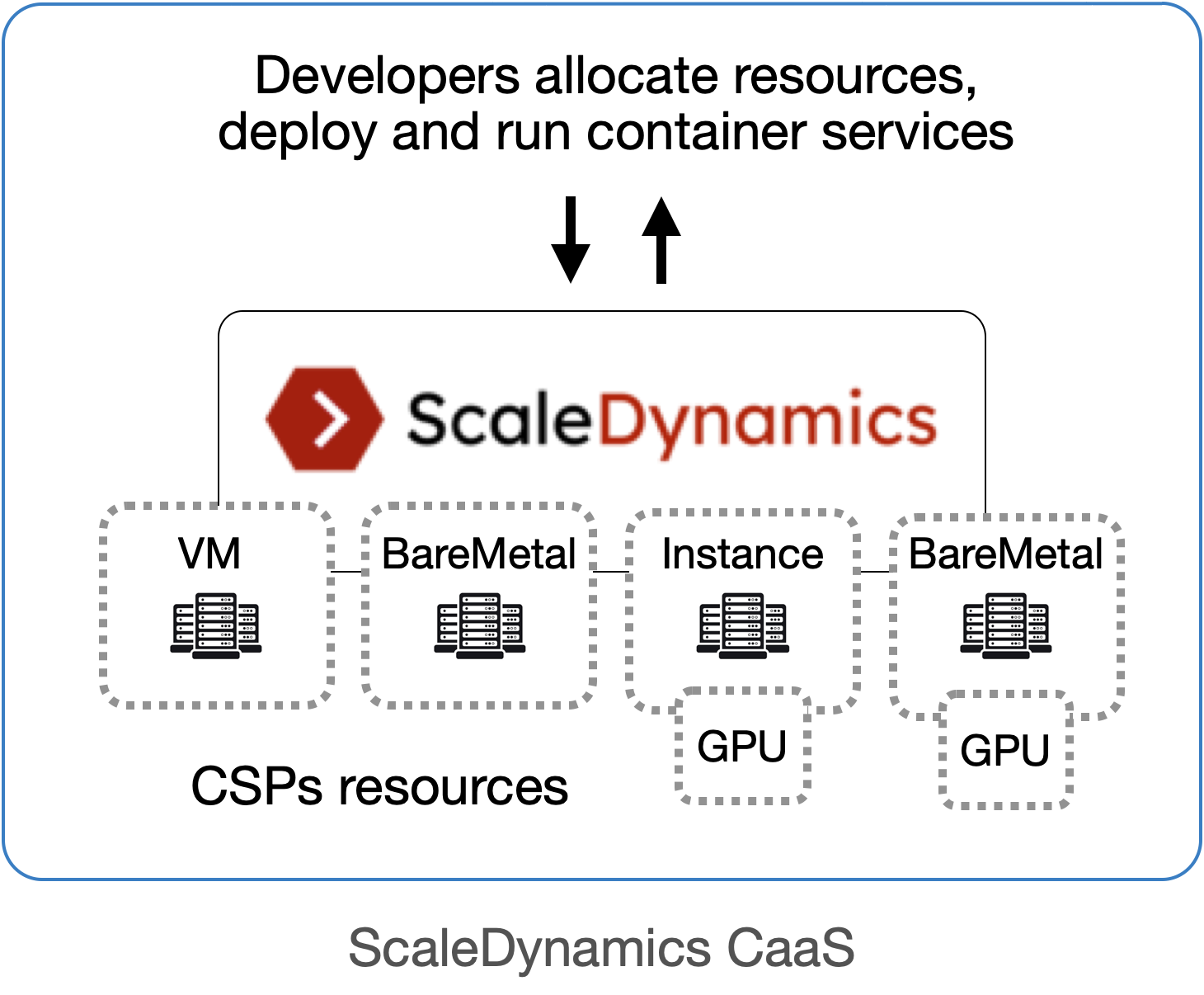Containers-as-a-Service
ScaleDynamics CaaS is an enterprise-grade Containers-as-a-Service platform operating containers at scale. It provides transparent container build, deployment and orchestration and use execution metrics to automatically scale container services up and down.
Our platform integrates a carbon calculator named OxygenIT that is able to compute the operational energy consumption and carbon footprint, and the embodied carbon footprint. OxygenIT can also be accessed using API, see OxygenIT section.
ScaleDynamics is cloud agnostic and supported several cloud service providers (CSPs) including all the major cloud providers, and regional ones. ScaleDynamics is also available for on-premise management.
With ScaleDynamics, developers can make new containerized apps, apis, SaaS, microservices, deploy and host them in the cloud without learning how the underlying infrastructure and the container deployment, management and orchestration stack (like Kubernetes) works. With CaaS, there is no additional software to install or configure, all is managed from resource allocation, container deployment, running and monitoring.

Why use containers
In the range of cloud computing services, CaaS is considered a kind of subset of Infrastructure-as-a-Service (IaaS) and is found between IaaS and Platform-as-a-Service (PaaS).
The basic resources of CaaS are containers, which are a popular deployment mechanism for cloud-native apps and microservices. CaaS also increases portability between environments, whether hybrid or multi-cloud.
Using containers has many benefits:
- Portability: Apps developed in containers have everything they need to run and can be deployed in multiple environments, including private and public clouds. Portability means flexibility because you can more easily move workloads between environments and providers.
- Scalability: Containers have the ability to scale dynamically vertically or horizontally when needed, enabling to manage dynamic traffic variations, and also reduce costs dramatically.
- Efficiency: Containers require fewer resources than virtual machines (VMs) since they don’t need a separate operating system. You can run several containers on a single server, enabling infrastructure cost reduction.
- Increased security: Containers are isolated from each other, which means if one container is compromised, others won’t be affected. Developer can incorporate specific security requirements and practices into golden images to maintain security requirements even in different cloud environments and different footprints.
- Speed: Because of their autonomy from the operating system, starting and stopping a container is a matter of seconds. This also allows for faster development and operational speed, as well as a faster, smoother user experience.
An advanced CaaS
Comparing to other CaaS, ScaleDynamics additional features:
- To use a CSP, just add a connector to the platform,
- Our catalog provides a large choice of cloud providers, regions, and configurations ready to use,
- Our CaaS supports GPU resources. You don't have to manage the setup of the underlying image, and focus on using the GPU from containers directly,
- Our built-in dynamics container workload move, provides developer to change any-time the cloud provider resource to run its container services. Manually upscale, downscale, move to another resource, region and also cloud provider in one command line. More that that, group or un-group containers across resources to reduce your infrastructure cost to the minimum.
- Our built-in Scalability provides a dynamic allocation/deallocation according to the infrastructure load.
OxygenIT carbon calculator and metrics
As we believe that Cloud/IT Sustainability is important, as described in the carbon calculator introduction our platform integrates a carbon calculator named OxygenIT that is able to compute the operational energy consumption and carbon footprint, and the embodied carbon footprint. The computation takes care of the provider, the location of the data center, the underlying infrastructure compoments, data center's POE and carbon energy provider emissions. It is compatible for public cloud infrastructures, custom or on-premise ones.
When using our platform, these metrics (Energy Consumption, Co2eq usage and Co2eq embodiment) are automatically provided for the infrastructure used by ScaleDynamics CaaS.
In case you want to compute the carbon footprint for your legacy code (bare metal servers, instances or VMs) that are not managed by ScaleDynamics you can use our OxygenIT carbon calculator APIs.
Want to know more about OxygenIT ? Have a look to OxygenIT documentation.
Whant to know more about Ox
Try our CaaS
Discover and try our ScaleDynamics Containers-as-a-Service:
- Deploy you first container service in less than 2' Get started
- Look to supported CSPs and how to connect them to the platform
- Discover our CSP resource catalog and how to manage runners
- Explore our features to manage your container services